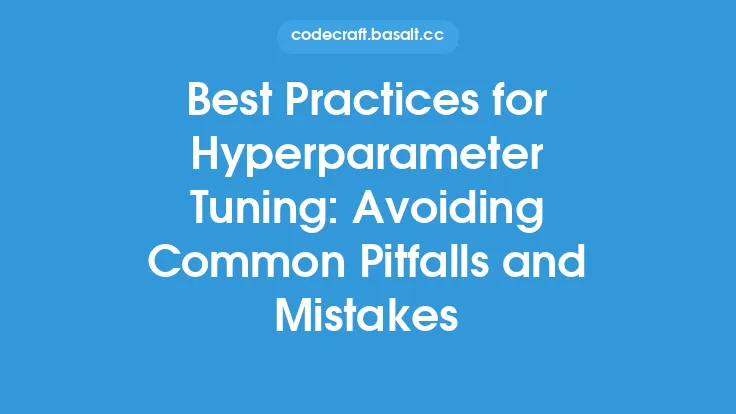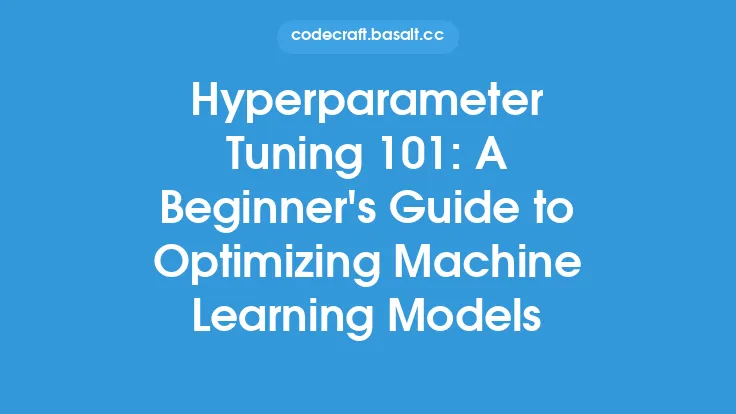Hyperparameter tuning is a crucial step in the machine learning workflow, as it enables data scientists to optimize the performance of their models. With the increasing complexity of machine learning algorithms, the need for efficient hyperparameter tuning techniques has become more pressing. In this article, we will delve into three popular hyperparameter tuning techniques: grid search, random search, and Bayesian optimization. These techniques have been widely adopted in the machine learning community and have proven to be effective in optimizing model performance.
Introduction to Hyperparameter Tuning Techniques
Hyperparameter tuning involves searching for the optimal combination of hyperparameters that results in the best performance of a machine learning model. Hyperparameters are parameters that are set before training a model, such as the learning rate, regularization strength, and number of hidden layers. The choice of hyperparameters can significantly impact the performance of a model, and finding the optimal combination can be a challenging task. There are several hyperparameter tuning techniques available, each with its strengths and weaknesses. In this article, we will focus on grid search, random search, and Bayesian optimization, which are three of the most popular techniques used in the machine learning community.
Grid Search
Grid search is a simple and intuitive hyperparameter tuning technique that involves searching through a predefined grid of hyperparameters. The grid is defined by specifying a range of values for each hyperparameter, and the search algorithm evaluates the model's performance at each point in the grid. The point with the best performance is selected as the optimal combination of hyperparameters. Grid search is a brute-force approach that can be computationally expensive, especially when dealing with a large number of hyperparameters. However, it is simple to implement and can be effective when the number of hyperparameters is small.
Random Search
Random search is another popular hyperparameter tuning technique that involves randomly sampling the hyperparameter space. The algorithm randomly selects a point in the hyperparameter space and evaluates the model's performance at that point. The process is repeated multiple times, and the point with the best performance is selected as the optimal combination of hyperparameters. Random search is more efficient than grid search, as it does not require evaluating the model's performance at every point in the grid. However, it may not always find the optimal combination of hyperparameters, especially when the hyperparameter space is large.
Bayesian Optimization
Bayesian optimization is a more advanced hyperparameter tuning technique that involves using a probabilistic approach to search for the optimal combination of hyperparameters. The algorithm uses a Bayesian model to predict the performance of the model at a given point in the hyperparameter space, and then selects the next point to evaluate based on the predicted performance. Bayesian optimization is more efficient than grid search and random search, as it uses a probabilistic approach to guide the search. It is also more effective, as it can adapt to the shape of the hyperparameter space and focus on the most promising regions.
Comparison of Hyperparameter Tuning Techniques
Grid search, random search, and Bayesian optimization are all effective hyperparameter tuning techniques, but they have different strengths and weaknesses. Grid search is simple to implement but can be computationally expensive. Random search is more efficient than grid search but may not always find the optimal combination of hyperparameters. Bayesian optimization is more advanced and effective but requires a good understanding of the underlying probabilistic models. The choice of hyperparameter tuning technique depends on the specific problem and the available computational resources.
Hyperparameter Tuning in Practice
Hyperparameter tuning is a critical step in the machine learning workflow, and it requires careful consideration of the underlying techniques. In practice, data scientists often use a combination of hyperparameter tuning techniques to optimize the performance of their models. For example, they may use grid search to identify the most promising regions of the hyperparameter space and then use Bayesian optimization to fine-tune the hyperparameters. Hyperparameter tuning can be time-consuming and requires significant computational resources, but it is essential for achieving good performance in machine learning models.
Challenges and Limitations
Hyperparameter tuning is a challenging task, and there are several limitations to the techniques discussed in this article. One of the main challenges is the curse of dimensionality, which refers to the exponential increase in the size of the hyperparameter space as the number of hyperparameters increases. This makes it difficult to search the entire hyperparameter space, and techniques like grid search and random search may not be effective. Another limitation is the computational cost of hyperparameter tuning, which can be significant, especially when dealing with large datasets and complex models.
Future Directions
Hyperparameter tuning is an active area of research, and there are several future directions that are being explored. One of the most promising areas is the use of automated machine learning (AutoML) techniques, which involve using machine learning algorithms to automate the hyperparameter tuning process. AutoML techniques have shown significant promise in optimizing the performance of machine learning models and reducing the need for human expertise. Another area of research is the use of transfer learning and meta-learning techniques, which involve using pre-trained models and meta-models to adapt to new tasks and datasets.
Conclusion
Hyperparameter tuning is a critical step in the machine learning workflow, and it requires careful consideration of the underlying techniques. Grid search, random search, and Bayesian optimization are three popular hyperparameter tuning techniques that have been widely adopted in the machine learning community. Each technique has its strengths and weaknesses, and the choice of technique depends on the specific problem and the available computational resources. Hyperparameter tuning is a challenging task, and there are several limitations to the techniques discussed in this article. However, with the increasing complexity of machine learning algorithms, the need for efficient hyperparameter tuning techniques has become more pressing, and researchers are actively exploring new techniques and approaches to optimize the performance of machine learning models.





